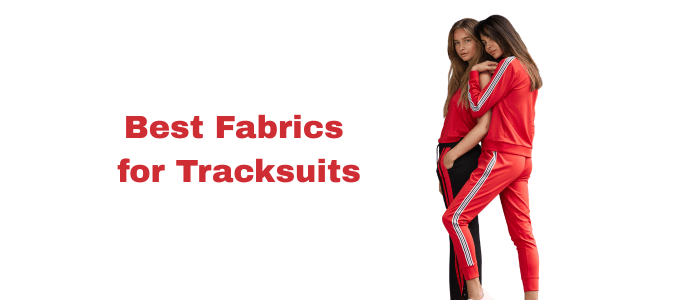Tracksuits are no longer just sportswear; they have become a fashion statement, a lifestyle essential, and a must-have in both athletic and casual wardrobes. In the United States, the athleisure market is set to grow by USD 176.3 billion from 2024 to 2028, reflecting surging demand for wearable performance fashion. This rising trend underscores the need for brands to choose the right tracksuit fabrics, those that deliver durability, comfort, and design.
For apparel brands, fashion startups, and private labels, selecting the right tracksuit fabrics is critical. The fabric not only determines durability and comfort but also shapes customer satisfaction, cost, and long-term value. In this guide, Argus Apparel breaks down the best fabric for tracksuits, explores popular tracksuit material types, and highlights the key trends shaping 2025.
Why Fabric Choice Matters for Tracksuits
Fabric serves as the backbone of any tracksuit, playing a critical role in comfort, performance, durability, and overall appearance. For apparel brands and private labels, the choice of fabric is not just a matter of looks; it fundamentally affects customer satisfaction, product longevity, and the reputation of the brand. It is imperative to understand why fabric selection is crucial to success:
1. Performance Benefits
Performance is at the core of any tracksuit, especially for activewear brands and sports teams.
- Breathability
Tracksuits used for training, gym sessions, or outdoor sports must allow proper airflow to regulate body temperature. Breathable fabrics help prevent overheating and keep athletes comfortable.
- Moisture-Wicking
High-performance fabrics like polyester blends actively draw sweat away from the skin, promoting dryness and reducing discomfort during workouts. This feature is essential for gym wear and professional sports apparel.
- Stretch and Mobility
Adding spandex or elastane provides flexibility, ensuring that the garment moves naturally with the body. This is especially important for athletes, dancers, and anyone engaging in high-mobility activities. A tracksuit that restricts movement can diminish performance and user satisfaction.
2. Style and Durability
Today, today, there are more than functional garments; they are also fashion statements.
- Durability
Quality fabrics ensure that tracksuits can withstand frequent washing and wear without losing their shape, color, or texture. For wholesale buyers and private labels, this translates into fewer returns and higher customer loyalty.
- Style Appeal
Smooth finishes, textured fabrics, or advanced dyeing techniques can elevate a tracksuit from basic to premium. Whether it’s a glossy nylon finish for outdoor wear or velour for a luxury athleisure line, fabric choice directly influences how the product is perceived in the market.
3. Cost Implications
Fabric selection also affects production budgets and pricing strategies.
- Premium Fabrics
Materials like organic cotton, velour, or recycled polyester may increase upfront costs but position the product as high-quality and eco-friendly, appealing to conscious consumers.
- Affordability vs. Performance
Wholesale buyers and startups often need to strike a balance. Blended fabrics (e.g., cotton-polyester mixes) provide cost efficiency while maintaining performance features.
- MOQ Considerations
Some specialty fabrics require higher minimum order quantities (MOQs), which may impact smaller fashion startups compared to established brands.
Best Fabrics for Tracksuits
Not all fabrics are created equally. Each type of fabric offers unique benefits, and the best choice depends on your target audience and product position.
Polyester
Polyester is one of the most widely used fabrics for tracksuits and activewear because of its balance between performance and affordability. It has become a favorite among sportswear brands in the USA due to its ability to manage heavy use, frequent washing, and exposure to outdoor elements without losing quality. Its resilience makes it especially reliable for wholesale orders and private-label collections where durability is non-negotiable.
- Features: Lightweight, durable, wrinkle-resistant, and quick-drying.
- Pros: Easy to maintain, holds color well, and suitable for performance-focused apparel.
- Cons: Can feel less breathable compared to natural fibers.
- Best Use Cases: Sports teams, gym wear brands, and wholesale tracksuits designed for durability.
Cotton Blends
Cotton blends offer a versatile middle ground by combining the softness of cotton with the added strength and flexibility of synthetic fibers like polyester or elastane. This makes them especially appealing for athleisure brands that want tracksuits to look stylish but still feel comfortable for everyday wear. Cotton blends also give private labels the opportunity to create lifestyle-focused collections with a premium feel that stands out in casual markets.
- Features: Soft, breathable, and comfortable for casual wear.
- Pros: Natural comfort, suitable for lifestyle-focused collections.
- Cons: Pure cotton may shrink and lacks moisture-wicking ability.
- Best Use Cases: Athleisure brands, casual private-label tracksuits.
Nylon
Nylon has earned a strong reputation in the activewear industry for its durability and sleek look. Nylon is especially effective for outdoor tracksuits, where durability against weather and wear is essential. Its smooth finish gives tracksuits a modern, performance-oriented look, making it a popular choice among brands that cater to active consumers. Although nylon can retain heat, its long-lasting quality and resistance to abrasions ensure that it remains in high demand for athletic apparel.
- Features: Smooth, lightweight, and water-resistant.
- Pros: Ideal for outdoor use, resistant to abrasions, and durable.
- Cons: Can feel warm in hot climates.
- Best Use Cases: Outdoor sports brands, all-weather tracksuits.
Spandex/Elastane (Blends)
Spandex, often referred to as elastane, is the fabric that provides the stretch customers expect in modern sportswear. It is rarely used on its own but is blended into other fabrics to add flexibility, shape retention, and comfort. This stretch element is what allows tracksuits to move seamlessly with the body, making it indispensable for training apparel and performance wear. In the US athleisure market, elastane blends are key to ensuring that tracksuits feel as good as they look.
- Features: High elasticity, soft hand feel, and shape retention.
- Pros: Perfect for sports, training, and fashion-forward designs.
- Cons: Not used alone—works best in blends.
- Best Use Cases: Gym wear, yoga-inspired tracksuits, movement-focused apparel.
Fleece
Fleece has become synonymous with warmth and comfort, making it one of the most popular choices for winter tracksuits and loungewear. Its insulating properties make it a practical option for brands targeting colder climates in the USA. Fleece tracksuits are especially appealing to consumers who want a balance of warmth and softness without the bulk of heavier materials like wool, making them a reliable choice for seasonal collections.
- Features: Insulating, soft, and comfortable.
- Pros: Retains heat, lightweight compared to wool.
- Cons: Too warm for summer or active sports.
- Best Use Cases: Winter tracksuits, loungewear collections, wholesale seasonal wear.
Velour
Velour has made a strong comeback in recent years, especially in the athleisure and fashion sectors. Its plush, velvet-like appearance gives tracksuits a premium look that appeals to trend-driven audiences. For brands aiming to create celebrity-inspired or fashion-forward collections, velour provides a luxury aesthetic that stands apart from traditional performance fabrics. While not practical for sports, it thrives in lifestyle and statement apparel.
- Features: Plush, velvet-like texture with a luxury look.
- Pros: Stylish, comfortable, and appealing for fashion-focused audiences.
- Cons: Less suited for sports performance.
- Best Use Cases: Athleisure, fashion startups, celebrity-inspired tracksuit collections.
Terry Cloth
Terry clothes are known for their practicality and comfort, making it an attractive option for tracksuits intended for gym and lounge wear. Its absorbent qualities allow it to double as a functional post-workout garment, while its softness enhances the relaxed appeal that consumers look for in loungewear. Although heavier than other materials, terry cloth provides a unique balance of comfort and utility, helping brands create versatile designs.
- Features: Loop-textured, soft, and absorbent.
- Pros: Great for post-workout wear, breathable.
- Cons: Heavier than other tracksuit fabrics.
- Best Use Cases: Lounge tracksuits, gym-focused private labels.
Sustainable Options
Sustainability is no longer a niche trend but a mainstream demand shaping the future of apparel. Brands in the USA are increasingly opting for fabrics such as recycled polyester and organic cotton to cater to eco-conscious consumers. These materials not only minimize environmental impact but also enhance brand reputation by demonstrating a commitment to responsible fashion. By 2025, sustainable fabrics will be the preferred choice for premium and custom collections.
- Recycled Polyester: Reduces waste and carbon footprint.
- Organic Cotton: Natural and environmentally responsible.
- Pros: Appeals to eco-conscious customers and strengthens brand reputation.
- Best Use Cases: Brands targeting green fashion, premium custom tracksuit fabric options.
Also check: Best Hoodie Materials: How to Choose the Right Hoodie Fabric for Your Collection
Factors to Consider When Choosing Tracksuit Fabric
Selecting the best fabric for tracksuits requires balancing multiple factors:
Seasonality
- Summer tracksuits work best with lightweight polyester or cotton blends.
- Winter tracksuits should be made from fleece or heavier blends.
Target Audience
- Athletes prefer breathable, stretch-focused fabrics.
- Lifestyle customers value softness and style.
Cost and MOQ Implications
- Premium fabrics, such as velour or organic cotton, may increase production costs.
- Bulk orders with polyester blends are more cost-efficient for wholesalers.
Fabric Trends for Tracksuits in 2025
The fabric landscape continues to evolve with innovation and customer demand. Key trends include:
- Sustainability at the Core
More brands in the USA are opting for recycled and organic fabrics to meet the expectations of eco-conscious consumers. This shift towards greener choices is driven by consumer demand, prompting apparel brands to incorporate materials like recycled polyester, organic cotton, and other low-impact textiles. Many private labels based in the US are also emphasizing sustainability as a core brand value, recognizing that it helps foster long-term customer loyalty. In addition to being environmentally friendly, these fabrics offer high quality, creating a win-win situation for both brands and consumers.
2. Performance-Enhancing Materials
Fabrics that offer UV protection, anti-odor treatments, and moisture-wicking properties are becoming increasingly popular. Today’s tracksuits are expected to do more than just look stylish; they must also enhance athletic performance and comfort. Fabrics designed with these features are gaining traction in both sportswear and athleisure markets. These performance characteristics make tracksuits versatile enough for workouts, travel, and everyday wear, appealing to a wide range of consumers.
3. Advanced Customization
Tracksuits that support digital printing, sublimation, and custom dyeing enable private labels and startups to create unique collections. Personalization remains a significant trend in fashion, and advancements in fabric technology are making it easier than ever to achieve. Materials designed for sublimation printing, digital printing, and advanced dyeing techniques allow these businesses to offer bold designs while maintaining high quality. From distinctive color combinations to branded graphics, these customization-friendly fabrics help companies stand out in a competitive market.
The fabric landscape for tracksuits has evolved beyond comfort; it now embodies innovation, sustainability, and changing consumer expectations. By 2025, brands will prioritize materials that strike a balance between style, functionality, and responsibility, all while providing consumers with more options for performance and personalization.
Conclusion
Choosing the right tracksuit fabrics is essential for balancing comfort, performance, and style. From durable polyester to luxurious velour, each material offers unique advantages depending on your audience and product goals.
In 2025, the best fabric for tracksuits will be those that combine functionality with sustainability. For apparel brands, private labels, and wholesalers in the USA, partnering with an expert manufacturer, like Argus Apparel, a tracksuit manufacturer, ensures access to high-quality tracksuit material types and custom solutions that align with market trends.
Whether your brand focuses on sports, lifestyle, or eco-friendly fashion, Argus Apparel can help you design tracksuits that meet your vision and resonate with your audience.










